Soil Erosion Modeling of Kinmen (Quemoy) Island, Taiwan: Toward Land Conservation in a Strategic Location
Abstract
1. Introduction
2. Materials and Methods
2.1. Study Site
2.2. The RUSLE and USPED Models
- A = computed soil loss per unit area (Mg ha−1 year−1).
- = rainfall–runoff erosivity factor (MJ mm ha−1 h−1 year−1).
- = soil erodibility factor (Mg hour MJ−1 mm−1).
- L = slope length factor (dimensionless).
- S = slope steepness factor (dimensionless).
- C = cover management factor (dimensionless).
- P = support practice factor (dimensionless).
- T = sediment flow at transport capacity (Mg m ha−1 year−1).
- = rainfall–runoff erosivity factor (MJ mm ha−1 h−1 year−1).
- = soil erodibility factor (Mg hour MJ−1 mm−1).
- = topographic sediment transport factor (m2 m−1).
- C = cover management factor (dimensionless).
- P = support practice factor (dimensionless).
- U = upslope contributing area per unit width (m2/m).
- = angle of the slope.
- m = empirical coefficient.
- n = empirical coefficient.
- ED = soil erosion or deposition (Mg ha−1 year−1).
- = aspect of the topography or the direction of flow.
- = (, ) = unit vector in the steepest slope direction.
2.3. Determination of the Factor
- E = total storm energy (MJ ha−1).
- = maximum 30 min intensity (mm h−1).
- = for storm i (MJ mm ha−1 h−1).
- j = number of storms in an N year period.
- = unit kinetic energy (MJ ha−1 mm−1).
- = rainfall intensity (mm h−1).
- = for increment r (MJ ha−1 mm−1).
- = rainfall depth for the increment of the storm hyetograph (mm).
2.4. Determination of the Factor
- = percent organic matter.
- s = soil-structure code.
- p = profile permeability class.
- M = (percent modified silt) × (percent silt + percent sand).
- = (%silt + %very fine sand) × (100 − %clay).
2.5. Determination of the and Factors
2.6. Determination of the and Factors
2.7. On-Site Field Observations
3. Results
3.1. Quantitative Assessment of Erosion Factors Using RUSLE and USPED
3.2. Comparison of Soil Erosion Estimates from RUSLE and USPED
3.3. Observed Field Evidence of Soil Erosion Depth
4. Discussion
4.1. Lack of Monitoring, Erosion Onset, and Annual Soil Loss Estimation
- Typhoon Lupit (2–9 August 2021).
- Tropical Depression WP242018 (22–26 August 2018).
- Typhoon Guchol (4–8 September 2017).
- Typhoon Meranti (15 September 2016; direct landfall on Kinmen).
4.2. Comparison with Neighboring Fujian Province
4.3. Management Implications for Kinmen
4.4. Study Limitations and Considerations
5. Conclusions
Supplementary Materials
Author Contributions
Funding
Institutional Review Board Statement
Informed Consent Statement
Data Availability Statement
Acknowledgments
Conflicts of Interest
References
- Pimentel, D.; Harvey, C.; Resosudarmo, P.; Sinclair, K.; Kurz, D.; McNair, M.; Crist, S.; Shpritz, L.; Fitton, L.; Saffouri, R.; et al. Environmental and economic costs of soil erosion and conservation benefits. Science 1995, 267, 1117–1123. [Google Scholar] [CrossRef] [PubMed]
- Montgomery, D.R. Soil erosion and agricultural sustainability. Proc. Natl. Acad. Sci. USA 2007, 104, 13268–13272. [Google Scholar] [CrossRef] [PubMed]
- Borrelli, P.; Alewell, C.; Alvarez, P.; Anache, J.A.A.; Baartman, J.; Ballabio, C.; Bezak, N.; Biddoccu, M.; Cerdà, A.; Chalise, D.; et al. Soil erosion modelling: A global review and statistical analysis. Sci. Total Environ. 2021, 780, 146494. [Google Scholar] [CrossRef] [PubMed]
- Panagos, P.; Borrelli, P.; Poesen, J.; Ballabio, C.; Lugato, E.; Meusburger, K.; Montanarella, L.; Alewell, C. The new assessment of soil loss by water erosion in Europe. Environ. Sci. Policy 2015, 54, 438–447. [Google Scholar] [CrossRef]
- Li, K.; Zhou, Z.; Wang, Z.; Zeng, Y.; Hubacek, K.; Borrelli, P.; Li, C.; Zhang, W.; Deng, Z.; Wang, J.; et al. Opportunity for mitigating soil loss by water erosion in cropland through crop switching and improved management in China. Geogr. Sustain. 2025, 6, 100262. [Google Scholar] [CrossRef]
- de Faria Godoi, R.; Rodrigues, D.B.B.; Borrelli, P.; Oliveira, P.T.S. High-resolution soil erodibility map of Brazil. Sci. Total Environ. 2021, 781, 146673. [Google Scholar] [CrossRef]
- Borrelli, P.; Robinson, D.A.; Panagos, P.; Lugato, E.; Yang, J.E.; Alewell, C.; Wuepper, D.; Montanarella, L.; Ballabio, C. Land use and climate change impacts on global soil erosion by water (2015–2070). Proc. Natl. Acad. Sci. USA 2020, 117, 21994–22001. [Google Scholar] [CrossRef]
- Liu, Y.-H.; Li, D.-H.; Chen, W.; Lin, B.-S.; Seeboonruang, U.; Tsai, F. Soil erosion modeling and comparison using slope units and grid cells in Shihmen reservoir watershed in Northern Taiwan. Water 2018, 10, 1387. [Google Scholar] [CrossRef]
- Tsai, F.; Lai, J.-S.; Nguyen, K.A.; Chen, W. Determining cover management factor with remote sensing and spatial analysis for improving long-term soil loss estimation in watersheds. ISPRS Int. J. Geo-Inf. 2021, 10, 19. [Google Scholar] [CrossRef]
- Chen, W.; Li, D.-H.; Yang, K.-J.; Tsai, F.; Seeboonruang, U. Identifying and comparing relatively high soil erosion sites with four DEMs. Ecol. Eng. 2018, 120, 449–463. [Google Scholar] [CrossRef]
- Lo, T.-W. Rainfall Factor and Mean Value Estimation of Shihmen Reservoir Sub-Watersheds. Master’s Thesis, National Taipei University of Technology, Taipei, Taiwan, 2020. (In Chinese). [Google Scholar]
- Liu, Y.-H. Analysis of Soil Erosion of Shihmen Reservoir Watershed in Taiwan and Lam Phra Ploeng Basin in Thailand. Master’s Thesis, National Taipei University of Technology, Taipei, Taiwan, 2019. (In Chinese). [Google Scholar]
- Liou, Y.-A.; Nguyen, Q.-V.; Hoang, D.-V.; Tran, D.-P. Prediction of soil erosion and sediment transport in a mountainous basin of Taiwan. Prog. Earth Planet. Sci. 2022, 9, 52. [Google Scholar] [CrossRef]
- Chen, W.; Nguyen, K.A.; Huang, Y.-C. Soil erosion in Taiwan. Agriculture 2023, 13, 1945. [Google Scholar] [CrossRef]
- Majhi, A.; Shaw, R.; Mallick, K.; Patel, P.P. Towards improved USLE-based soil erosion modelling in India: A review of prevalent pitfalls and implementation of exemplar methods. Earth-Sci. Rev. 2021, 221, 103786. [Google Scholar] [CrossRef]
- Chen, W.; Huang, Y.-C.; Lebar, K.; Bezak, N. A systematic review of the incorrect use of an empirical equation for the estimation of the rainfall erosivity around the globe. Earth-Sci. Rev. 2023, 238, 104339. [Google Scholar] [CrossRef]
- Gouma, M.; van Wijngaarden, G.J.; Soetens, S. Assessing the effects of geomorphological processes on archaeological densities: A GIS case study on Zakynthos Island, Greece. J. Archaeol. Sci. 2011, 38, 2714–2725. [Google Scholar] [CrossRef]
- Mitasova, H.; Barton, M.; Ullah, I.; Hofierka, J.; Harmon, R.S. GIS-based soil erosion modeling. In Treatise on Geomorphology: Volume 1–14; Elsevier: Amsterdam, The Netherlands, 2013; pp. 228–258. [Google Scholar]
- Renard, K.G.; Foster, G.R.; Weesies, G.A.; McCool, D.K.; Yoder, D.C. Predicting Soil Erosion by Water: A Guide to Conservation Planning with the Revised Universal Soil Loss Equation (RUSLE). In Agricultural Handbook; United States Department of Agriculture: Washington, DC, USA, 1997; p. 703. [Google Scholar]
- Mitasova, H.; Hofierka, J.; Zlocha, M.; Iverson, L.R. Modelling topographic potential for erosion and deposition using GIS. Int. J. Geogr. Inf. Syst. 1996, 10, 629–641. [Google Scholar] [CrossRef]
- Mitasova, H.; Brown, W.M.; Johnston, D.; Mitas, L. GIS tools for erosion/deposition modelling and multidimensional visualization. In Part III: Process Based Erosion Simulation. Geographic Modelling and Systems Laboratory; University of Illinois Urbana-Champaign: Champaign, IL, USA, 1996. [Google Scholar]
- Chen, W.; Wang, W.-H.; Nguyen, K.A. Soil erosion and deposition in a Taiwanese watershed using USPED. Sustainability 2022, 14, 3397. [Google Scholar] [CrossRef]
- Wu, C.-T.; Lin, E.-S. Geology and Landscapes of Kinmen. In Kinmen Academic Series; Dow Tien Publishing House: New York, NY, USA, 1998; Volume 11. (In Chinese) [Google Scholar]
- Chen, C.-H. Kinmen Island Geological Survey and Research. Geophysics 1986, 7, 14–25. (In Chinese) [Google Scholar]
- Lin, C.-C.; Chen, P.-Y.; Lin, F.-Y. Report on the Geology and Mineral Deposits in Quemoy Islands, Fuchien; MRSO: Hollywood, FL, USA, 1970. (In Chinese) [Google Scholar]
- Chen, P.-Y. Studies of the Quaternary Clays and Clay Minerals from Chinmen Island, Fukien. Taiwan Min. Ind. 1965, 2–4, 66–92. (In Chinese) [Google Scholar]
- Halperin, M.H. The 1958 Taiwan Straits Crisis: A Documented History; Rand Corporation: Santa Monica, CA, USA, 1996. [Google Scholar]
- Wan, T.-L.A. Islands, geopolitics and language ideologies: Sociolinguistic differentiation between Taiwanese and Kinmenese Hokkien. Lang. Commun. 2022, 83, 36–48. [Google Scholar] [CrossRef]
- Tsai, C.-W. A Strategy Study of Tourism Development for Kinmen after the Implementation of Individual Visit of Mini Three Links. J. Natl. Quemoy Univ. 2012, 2, 235–254. (In Chinese) [Google Scholar]
- Kuo, C.-M.; Chen, Z.-S. The Project of Investigation of Soil and Vegetation Analysis in Kinmen National Park; Kinmen National Park Headquarters, Construction and Planning Agency, Ministry of the Interior: Kinmen, Taiwan, 2002.
- Chen, C.-T. Introduction to Kinmen Studies; National Quemoy University: Kinmen, Taiwan, 2022. (In Chinese) [Google Scholar]
- Lal, R.; Bouma, J.; Brevik, E.; Dawson, L.; Field, D.J.; Glaser, B.; Hatano, R.; Hartemink, A.E.; Kosaki, T.; Lascelles, B.; et al. Soils and sustainable development goals of the United Nations: An International Union of Soil Sciences perspective. Geoderma Reg. 2021, 25, e00398. [Google Scholar] [CrossRef]
- Borrelli, P.; Märker, M.; Schütt, B. Modelling post-tree-harvesting soil erosion and sediment deposition potential in the Turano River Basin (Italian Central Apennine). Land Degrad. Dev. 2015, 26, 356–366. [Google Scholar] [CrossRef]
- Harmon, B.A.; Mitasova, H.; Petrasova, A.; Petras, V. r.sim.terrain 1.0: A landscape evolution model with dynamic hydrology. Geosci. Model Dev. 2019, 12, 2837–2854. [Google Scholar] [CrossRef]
- Mitasova, H.; Mitas, L. Multiscale soil erosion simulations for land use management. In Landscape Erosion and Evolution Modeling; Springer: Berlin/Heidelberg, Germany, 2001; pp. 321–347. [Google Scholar]
- Lin, W.; Lee, C.-Y.; Yang, H.-C.; Chen, C.-H. Geological Map of Taiwan Scale 1:50,000 in Kinmen Area; Central Geological Survey, Ministry of Economic Affairs: New Taipei City, Taiwan, 2011. (In Chinese)
- Lin, L.-L.; Chang, S.-T. Study of Soil Erodibility Factor Estimation Equations. J. Chin. Soil Water Conserv. 2008, 39, 355–366. (In Chinese) [Google Scholar]
- Desmet, P.J.J.; Govers, G. A GIS procedure for automatically calculating the USLE LS factor on topographically complex landscape units. J. Soil Water Conserv. 1996, 51, 427–433. [Google Scholar] [CrossRef]
- Chen, W.; Nguyen, K.A. The New Island-Wide LS Factors of Taiwan, with Comparison with EU Nations. Sustainability 2022, 14, 3059. [Google Scholar] [CrossRef]
- Wang, W.-H. Analyzing Soil Erosion and Deposition Using USPED in the Shihmen Reservoir Watershed. Master’s Thesis, National Taipei University of Technology, Taipei, Taiwan, 2022. (In Chinese). [Google Scholar]
- Central Weather Administration. Kinmen Weather Station: Station Characteristics; Central Weather Administration: Taipei, Taiwan. Available online: https://etour.cwa.gov.tw/station_inpage.php?stn_id=17 (accessed on 16 August 2024). (In Chinese)
- Fang, G.Q.; Ruan, F.S.; Wu, X.H.; Guo, Z.M. Main features of soil erodibility in Fujian province. Soil Water Conserv. Fujian 1997, 2, 19–23. [Google Scholar]
- Wang, B.; Zheng, F.; Guan, Y. Improved USLE-K factor prediction: A case study on water erosion areas in China. Int. Soil Water Conserv. Res. 2016, 4, 168–176. [Google Scholar] [CrossRef]
- Wang, X.Q.; Zeng, S.J.; Chen, X.G.; Lin, J.L.; Chen, S.M. Change analysis on soil erosion of Fujian Province from 1990 to 2015. Int. Arch. Photogramm. Remote Sens. Spat. Inf. Sci. 2017, 42, 1381–1386. [Google Scholar] [CrossRef]
- Chen, S.; Zha, X. Effects of the ENSO on rainfall erosivity in the Fujian Province of southeast China. Sci. Total Environ. 2018, 621, 1378–1388. [Google Scholar] [CrossRef]
- Ye, H.; Hua, W.; Huang, C.; Huang, T.; Wang, H.; Yuan, X.; Yang, H. Quantitative evaluation of soil erosion in the upper Minjiang River Basin of China based on integration of geospatial technologies using RUSLE. Pol. J. Environ. Stud. 2020, 29, 3419–3429. [Google Scholar] [CrossRef]
- Li, C.; Lin, L.; Hao, Z.; Post, C.J.; Chen, Z.; Liu, J.; Yu, K. Developing a USLE cover and management factor (C) for forested regions of southern China. Front. Earth Sci. 2020, 14, 660–672. [Google Scholar] [CrossRef]
- Gao, J.; Shi, C.; Yang, J.; Yue, H.; Liu, Y.; Chen, B. Analysis of spatiotemporal heterogeneity and influencing factors of soil erosion in a typical erosion zone of the southern red soil region, China. Ecol. Indic. 2023, 154, 110590. [Google Scholar] [CrossRef]
- Xie, X.; Wang, X.; Wang, Z.; Lin, H.; Xie, H.; Shi, Z.; Liu, X. Influence of landscape pattern evolution on soil conservation in a red soil hilly watershed of Southern China. Sustainability 2023, 15, 1612. [Google Scholar] [CrossRef]
- Xu, J.; Jiang, X.; Liu, H.; Yin, F.; Xu, Y.; Gao, C. Monitoring of spatiotemporal changes in ecosystem service functions and analysis of influencing factors in Pingtan Island. Ecol. Indic. 2024, 158, 111590. [Google Scholar] [CrossRef]
- Huang, Y.-C. Soil Erosion and Deposition of Kinmen. Master’s Thesis, National Taipei University of Technology, Taipei, Taiwan, 2023. (In Chinese). [Google Scholar]
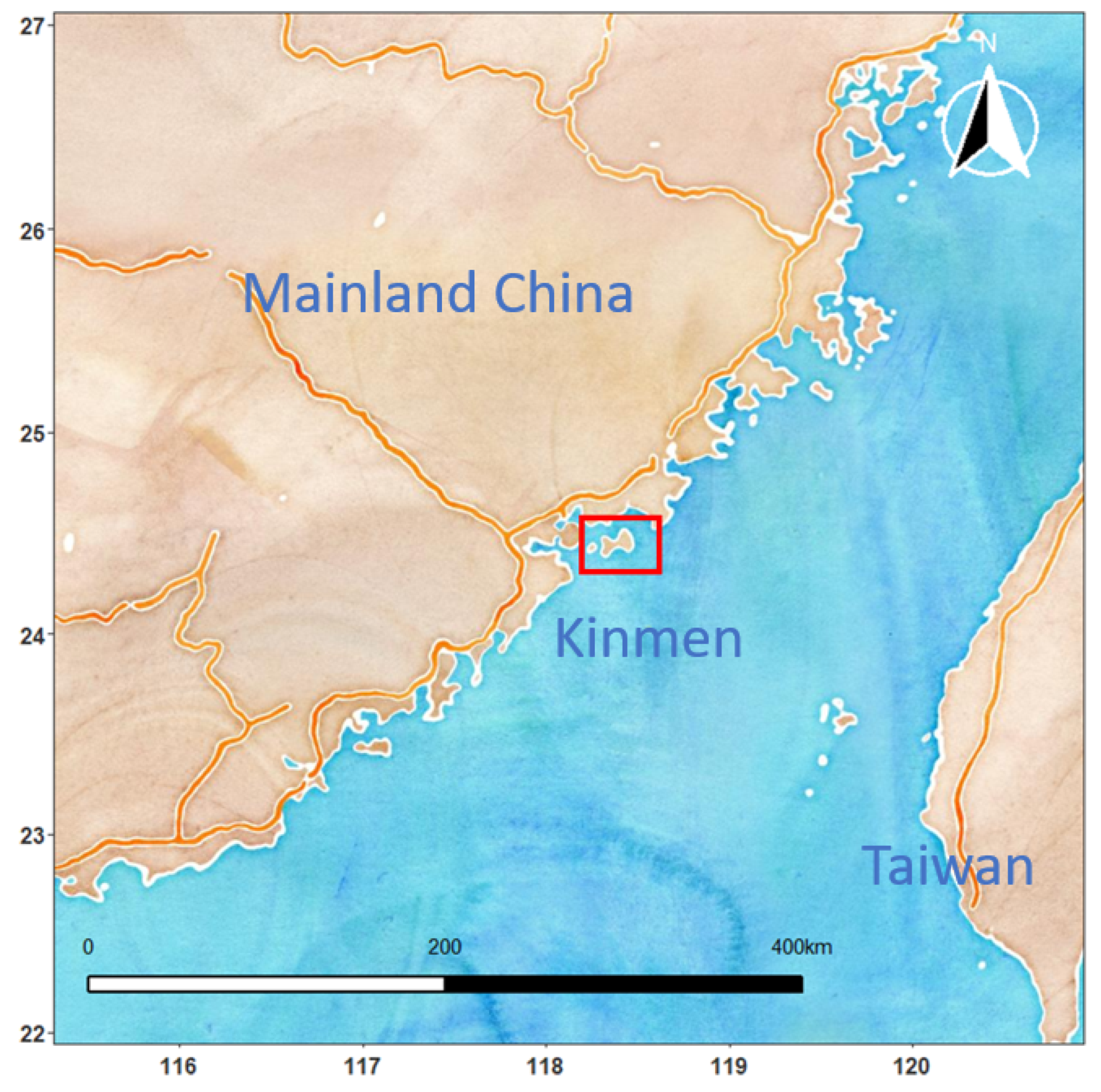

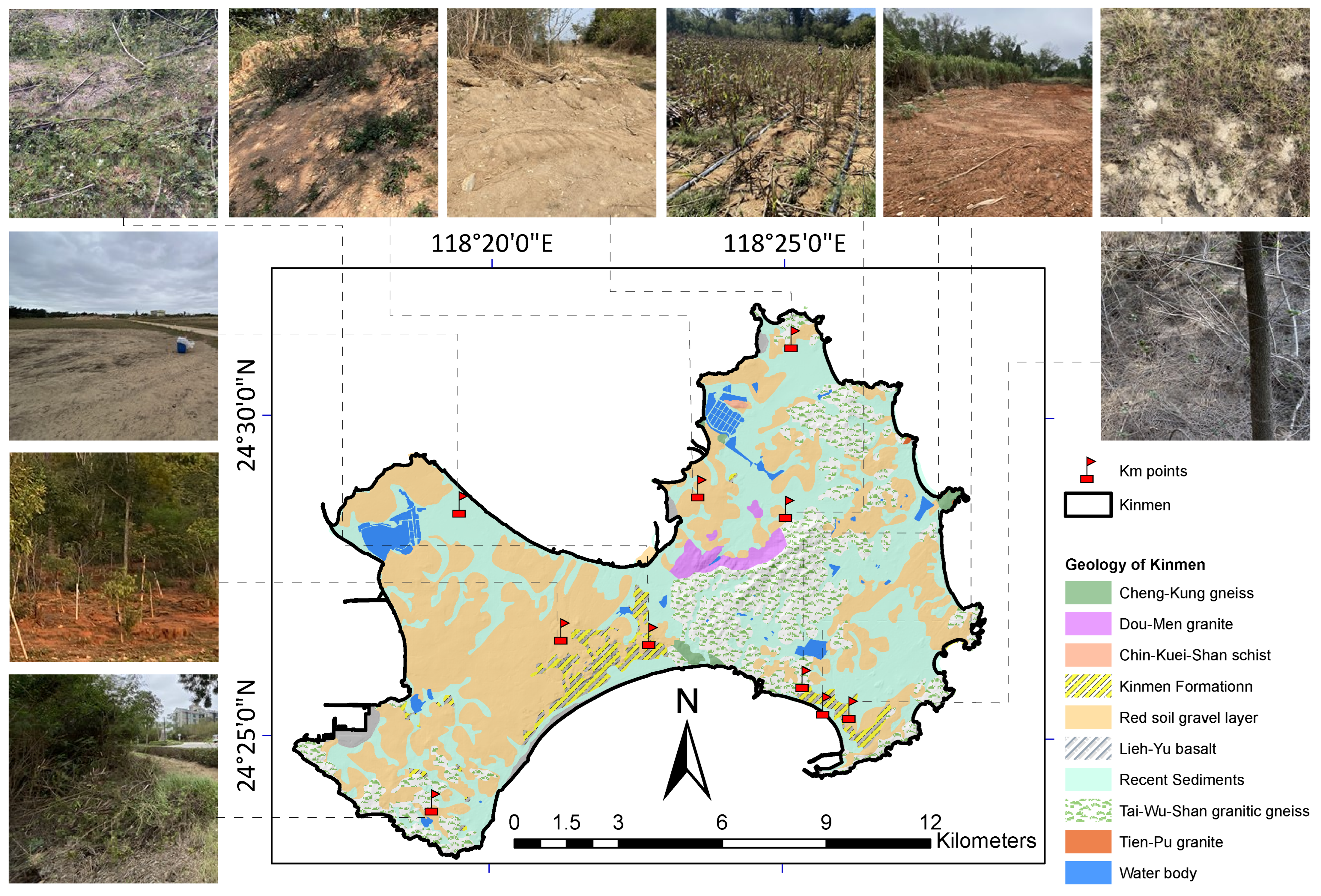
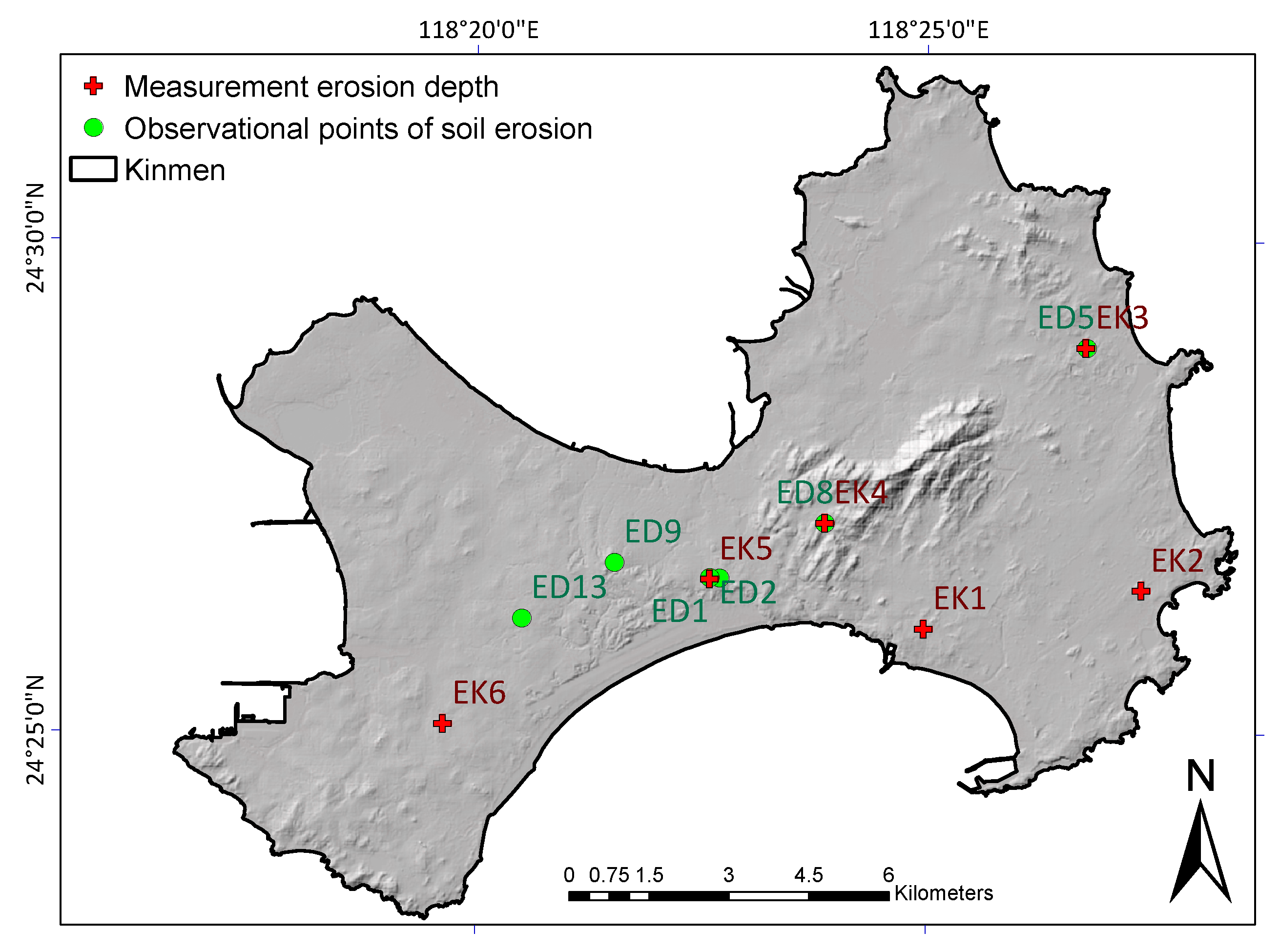

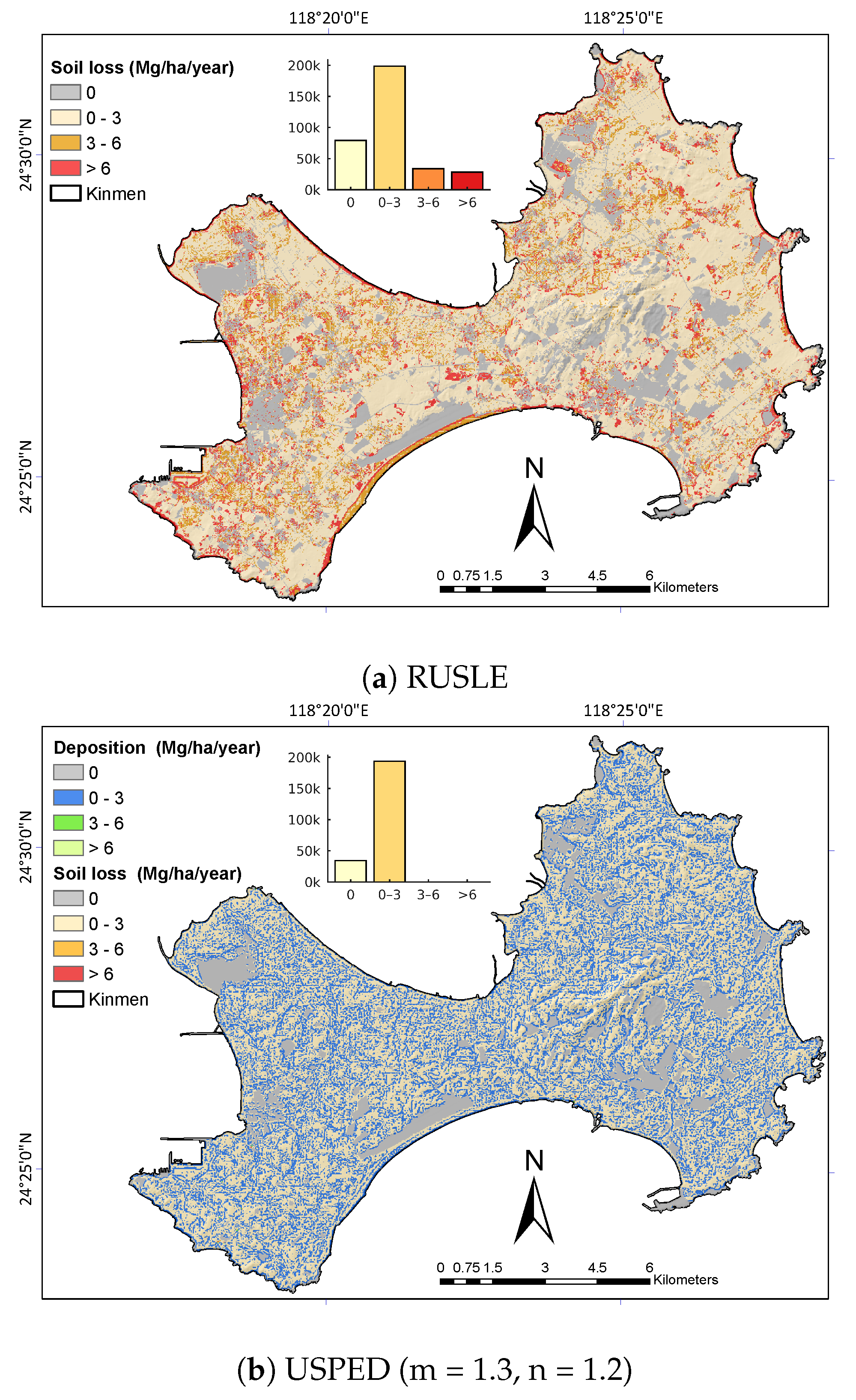


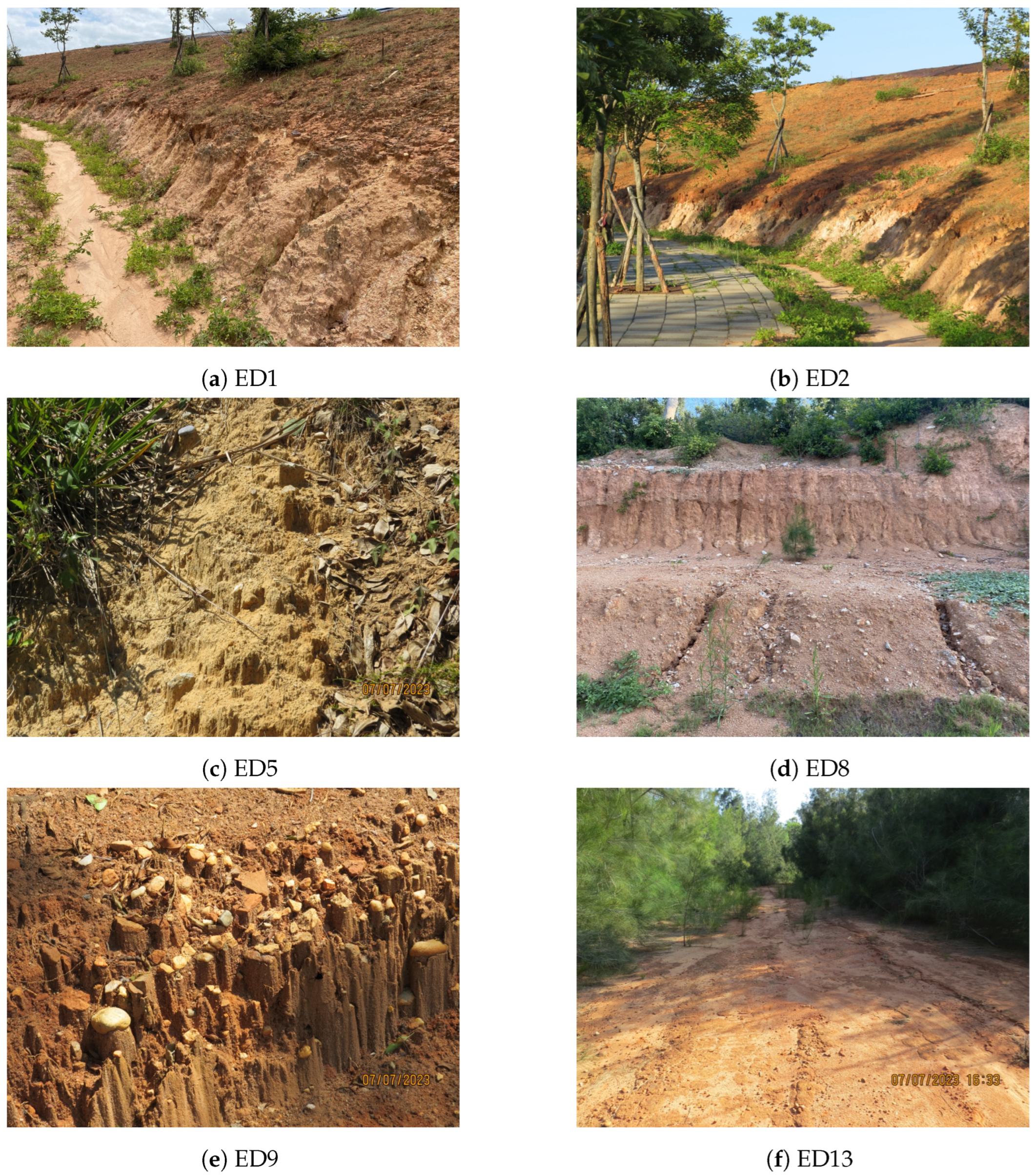

| Data Type/Factor | Source | Resolution/Accuracy | Notes |
|---|---|---|---|
| Rainfall data () | Central Weather Administration (CWA) | 1 min data (2018–2022), aggregated to 15 min intervals | Four stations on Kinmen; some data gaps in 2021 due to equipment failure |
| Soil samples () | Field surveys (10 sites), laboratory analysis | Particle size distribution by ASTM sieve/hydrometer methods; in situ permeability (limited) | 18 samples analyzed; universal kriging interpolation |
| DEM (LS, ) | Ministry of the Interior | 20 m resolution DEM | Used to calculate LS and factors |
| Land use/land cover (, ) | National Land Surveying and Mapping Center | General 2021 dataset, spatial resolution not specified | values adapted from Shihmen Reservoir study, modified for Kinmen |
| Field surveys (observation) | Authors’ fieldwork (July 2023) | Locations recorded with handheld GPS; erosion depth measured with mm precision | 24 locations inspected, 6 sites with erosion depth measurements |
| C Value | LULC Types |
|---|---|
| 0.000 | Aquaculture, Airport, General Road, Road-related facilities, Commercial port, Fishing port, River, Irrigation canal, Reservoir, Lake, Water storage pond, Waterway sandbar, Embankment, Water gate, Pumping station, Groundwater extraction well, Other water facilities, Flood prevention road, Retail and wholesale, Service industry, Residential area, Residential area used for both residential and industrial purposes, Residential area used for both residential and commercial purposes, Residential area used for both residential and other purposes, Manufacturing industry, Warehouses, Religious facilities, Funeral facilities, Under construction, Others, Government agencies, Kindergarten, Elementary school, Junior high school, College/University, Medical and healthcare, Social welfare facilities, Meteorological facilities, Electricity, Gas, Tap water, Gas station, Environmental facilities, Legally designated cultural assets, General cultural facilities, Other cultural facilities, Amusement places, Sports facilities, Reef |
| 0.003 | Park and green space |
| 0.010 | Livestock and poultry houses, Agricultural production facilities, Agricultural marketing and processing facilities, Broad-leaved Forest, Bamboo Forest, Bamboo-broad-leaved mixed forest |
| 0.030 | Grassland |
| 0.050 | Pasture, Landslide area |
| 0.100 | Paddy field |
| 0.160 | Orchard |
| 0.228 | Rainfed field |
| 0.500 | Beach |
| 0.600 | Unused land |
| 0.700 | Earth and stone works and related facilities, Land undergoing anthropogenic modifications |
| 0.800 | Construction waste and soil storage and treatment facilities |
| Factor | Average | Max | Min |
|---|---|---|---|
| (MJ mm ha−1 h−1 year−1) | 3352 | 3740 | 3102 |
| (Mg hour MJ−1 mm−1) | 0.0090 | 0.0117 | 0.0063 |
| 0.95 | 29.85 | 0.03 | |
| (m2/m) , | 13.20 | 18,713.92 | 0 |
| (m2/m) , | 60.57 | 210,962.56 | 0 |
| 0.12 | 0.80 | 0 |
| RUSLE | USPED (m = 1.3, n = 1.2) | USPED (m = 1.6, n = 1.3) | |
|---|---|---|---|
| Erosion (Mg ha−1 year−1) | 2.17 | 0.87 | 3.79 |
| Deposition (Mg ha−1 year−1) | - | 1.39 | 6.51 |
| Sheet Erosion | EK1 | EK2 | EK3 | EK4 | EK5 | EK6 |
|---|---|---|---|---|---|---|
| Number of measurements | 9 | 3 | 11 | 5 | 7 | 18 |
| Mean cumulative | ||||||
| erosion depth (mm) | 69.2 | 32.7 | 59.1 | 23.6 | 26.9 | 53.6 |
| Standard deviation (mm) | 21.9 | 2.5 | 15.4 | 3.0 | 8.8 | 16.3 |
| Location | Model | Avg. Annual Precip. (mm) | (MJ mm ha−1 hr−1 yr−1) | (Mg hr MJ−1 mm−1) | LS | C | P | Soil Erosion (Mg ha−1 yr−1) | Ref. |
|---|---|---|---|---|---|---|---|---|---|
| Kinmen | RUSLE | 745.9 | 3352 | 0.009 | 0.95 | 0.12 | 1 | 2.17 | This study |
| Fujian Province | USLE | - | - | 0.0329 | - | - | - | - | Orig. in [42], cited in [43] |
| Fujian Province | USLE | - | - | 0.0251 (non-standard USLE) | - | - | - | - | [43] |
| Fujian Province | USLE | - | - (Emp. Eq.) | 0.1626–0.2708 (Figure 3, no unit) | - | - | - | 80%: 5–25 | [44] |
| Fujian Province | USLE | 1614.01 | 6771.80–14,828.23 (non-standard RUSLE) | - | - | - | - | - | [45] |
| Upper Minjiang River Basin, Fujian Province | RUSLE | 1692–2677 (Figure 3a) | 289.4–460.6 (Figure 3b) * | 0–0.216 (Figure 4b) ** | 0–3 (Figure 5b) | 0–0.31 (Figure 6a) | 0–1 (Figure 6b) | 1.3783–6.9227 | [46] |
| Hetian Town, Fujian Province | USLE | 1750.8 | - | 0.22 (Emp. Data) | - | 0.18 (Masson pine forest) | - | - | [47] |
| Changting County, Fujian Province | RUSLE | 1737 | - (Emp. Eq.) | - (non-standard RUSLE) | - | - | - | 3.38 (2020) | [48] |
| Tingjiang Watershed, Fujian Province | InVEST-SDR (based on USLE) | 1450–2200 | - (Emp. Eq.) | - (non-standard USLE) | - | - | - | 993.6–12,085.01 (2020, Figure 5) | [49] |
| Pingtan Island, Fujian Province | RUSLE | - | 636.81–777.14 (2020, Figure 9) | 0–0.185 (Figure 9) ** | 0–229.65 (Figure 9) | 1.263–2.489 (2020, Figure 9) *** | 0.2–1.71 (Figure 9) | 0–8099 (Figure 9) | [50] |
Disclaimer/Publisher’s Note: The statements, opinions and data contained in all publications are solely those of the individual author(s) and contributor(s) and not of MDPI and/or the editor(s). MDPI and/or the editor(s) disclaim responsibility for any injury to people or property resulting from any ideas, methods, instructions or products referred to in the content. |
© 2025 by the authors. Licensee MDPI, Basel, Switzerland. This article is an open access article distributed under the terms and conditions of the Creative Commons Attribution (CC BY) license (https://creativecommons.org/licenses/by/4.0/).
Share and Cite
Huang, Y.-C.; Nguyen, K.A.; Chen, W. Soil Erosion Modeling of Kinmen (Quemoy) Island, Taiwan: Toward Land Conservation in a Strategic Location. Sustainability 2025, 17, 10052. https://doi.org/10.3390/su172210052
Huang Y-C, Nguyen KA, Chen W. Soil Erosion Modeling of Kinmen (Quemoy) Island, Taiwan: Toward Land Conservation in a Strategic Location. Sustainability. 2025; 17(22):10052. https://doi.org/10.3390/su172210052
Chicago/Turabian StyleHuang, Yu-Chieh, Kieu Anh Nguyen, and Walter Chen. 2025. "Soil Erosion Modeling of Kinmen (Quemoy) Island, Taiwan: Toward Land Conservation in a Strategic Location" Sustainability 17, no. 22: 10052. https://doi.org/10.3390/su172210052
APA StyleHuang, Y.-C., Nguyen, K. A., & Chen, W. (2025). Soil Erosion Modeling of Kinmen (Quemoy) Island, Taiwan: Toward Land Conservation in a Strategic Location. Sustainability, 17(22), 10052. https://doi.org/10.3390/su172210052









